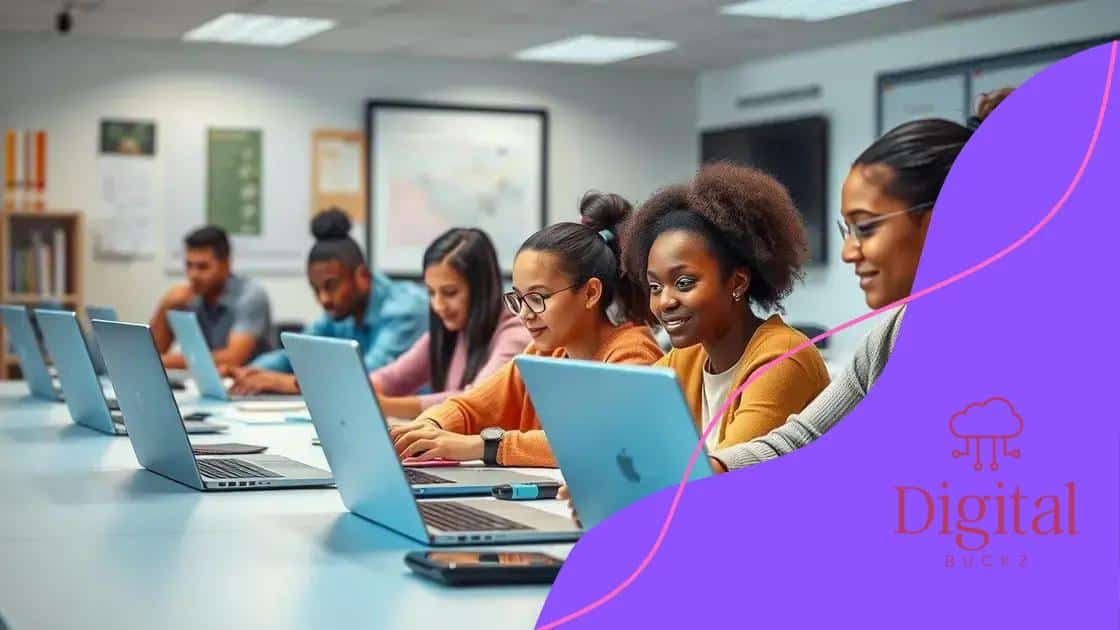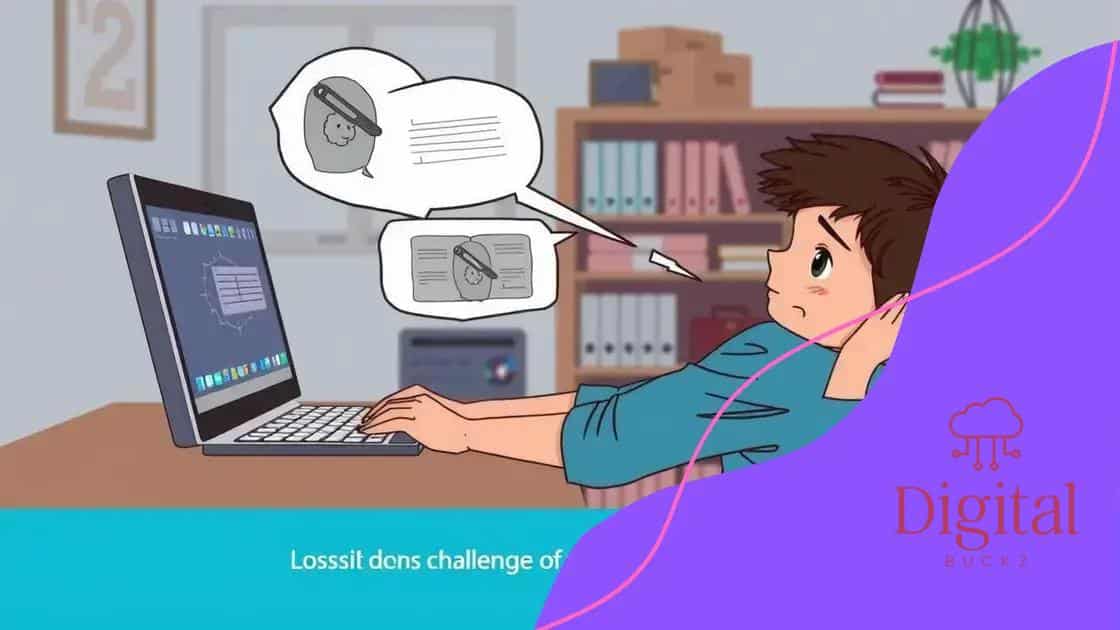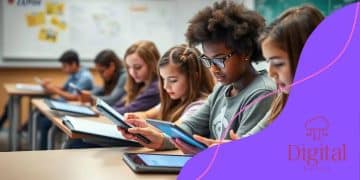The impact of virtual classrooms on traditional education

The impact of virtual classrooms on traditional education is significant, as they provide flexibility, personalized learning experiences, and access to diverse resources while also posing challenges such as feelings of isolation and the need for self-discipline.
The impact of virtual classrooms on traditional education is undeniable. Have you ever wondered how digital platforms change the way we learn? Let’s dive into this fascinating shift.
Understanding virtual classrooms
Understanding virtual classrooms provides insight into how technology is shaping modern education. These environments enable students to learn from anywhere, creating flexible and accessible learning opportunities.
In a virtual classroom, students can interact with teachers and peers through video conferencing tools. They can access learning materials, participate in discussions, and submit assignments online. This modern approach to education offers a unique blend of convenience and effectiveness.
Key Features of Virtual Classrooms
Virtual classrooms offer several important features that enhance the learning experience.
- Interactive Tools: Features like polls, quizzes, and breakout rooms engage students actively.
- Recorded Sessions: Classes can be recorded, allowing students to revisit lessons at their convenience.
- Diverse Learning Resources: Access to various online materials enriches the educational experience.
These classrooms promote collaboration among students and foster relationships despite physical distances. The use of digital tools helps improve communication, allowing for quicker feedback and support.
Furthermore, virtual classrooms facilitate personalized learning. Students can progress at their own pace, revisiting challenging topics as needed.
As more institutions adopt virtual classrooms, it is essential to explore their potential fully. Understanding how these tools work can help establish a more effective learning environment for all.
Advantages of virtual learning
The advantages of virtual learning are significant and increasingly recognized in the education sector. This mode of learning offers unparalleled flexibility, allowing students to access their classes from any location at their convenience.
One key benefit is the ability to tailor educational experiences. Students can choose when to study and review materials according to their own schedules. This is especially helpful for those balancing work or family responsibilities.
Flexibility and Accessibility
Virtual learning breaks down barriers that traditional classrooms often present. Students can connect from anywhere, meaning they can participate in classes that may not be offered locally.
- Global Access: Students can engage with educators from around the world, gaining different perspectives and knowledge.
- Resource Availability: With online platforms, learners can access a wealth of materials easily, from videos to articles.
- Self-Paced Learning: Students can progress at their own speed, allowing greater focus on challenging subjects.
Another advantage is the cost-effectiveness. Virtual learning often reduces costs related to commuting, materials, and even tuition fees. This makes quality education more attainable for many.
Furthermore, virtual environments encourage the use of technology in learning. This not only prepares students for the digital world but also enhances technical skills that can be valuable in their future careers.
The adaptability of virtual learning allows for personalized educational experiences. Educators can modify their teaching styles to better meet the needs of individual students, fostering a more inclusive atmosphere.
Challenges faced in virtual education

The challenges faced in virtual education can impact learning experiences for students and teachers alike. While this mode offers many benefits, it also presents unique obstacles that need to be addressed.
One of the most significant challenges is the lack of personal interaction. Face-to-face communication fosters relationships and creates a sense of community in traditional classrooms. In virtual settings, students may feel isolated, making engagement more difficult.
Technical Issues
Technical problems also pose challenges for virtual education. Connectivity issues can disrupt classes, preventing students from accessing essential resources.
- Internet Reliability: A stable internet connection is crucial for seamless learning experiences.
- Device Limitations: Not every student has access to the latest technology, which can create disparities.
- Platform Familiarity: Students and teachers may struggle with unfamiliar digital tools, leading to frustration.
Another challenge is self-discipline. Without the structured environment of a physical classroom, some students may find it harder to stay focused and motivated. The freedom of virtual learning can lead to distractions, making it essential for learners to develop strong time management skills.
Furthermore, assessments in virtual education can be problematic. Ensuring academic integrity can be more difficult when students take tests from home. Educators must find new ways to evaluate student performance fairly.
Teachers also face increased workloads as they adapt lessons and materials for online platforms. This modification process can be time-consuming and requires ongoing training to effectively use digital tools.
Comparing traditional and virtual classrooms
Comparing traditional and virtual classrooms highlights the strengths and weaknesses of both learning environments. Understanding these differences can help students and educators choose the best approach for their needs.
Traditional classrooms are often praised for their personal interaction. Students benefit from face-to-face communication with teachers and peers, fostering connections and engagement. This environment supports hands-on activities and immediate feedback.
Structure and Routine
One clear advantage of traditional settings is the structured routine they provide. Students attend classes at fixed times and locations, helping them develop discipline and time management skills.
- Fixed Schedule: Set hours promote a consistent learning rhythm.
- Classroom Environment: Physical spaces allow for collaborative learning through group work.
- Resource Availability: Access to libraries and labs enhances the educational experience.
On the other hand, virtual classrooms offer unmatched flexibility. Students can learn from anywhere, which is ideal for those with busy schedules or geographic limitations. They can also choose from a wider variety of courses, connecting with educators worldwide.
However, virtual classrooms come with the challenge of missing personal interactions. Students might feel isolated and struggle to engage actively in discussions. Teachers must find innovative ways to maintain participation and connection in digital formats.
Another important factor is access to resources. Traditional classrooms provide direct access to materials and facilities; virtual learning requires reliable technology and internet connection, which not all students have.
Ultimately, both traditional and virtual classrooms offer valuable educational experiences. The choice between them depends on personal preferences, learning styles, and individual needs.
Future of education with technology
The future of education with technology is bright and full of possibilities. As schools and universities integrate more digital tools, learning will continue to evolve.
One major trend is the rise of personalized learning experiences. Technology allows educators to tailor lessons to meet the needs of each student. This approach can improve engagement and understanding, helping children grasp complex topics more effectively.
Adaptive Learning Systems
Adaptive learning systems use algorithms to assess student performance and adjust content accordingly. This means that students can receive support exactly where they need it.
- Individualized Resources: Customized materials help address learning gaps.
- Real-time Feedback: Immediate insights allow for quick adjustments to enhance learning.
- Progress Tracking: Monitoring tools enable students to see their improvement over time.
Furthermore, the use of virtual reality (VR) and augmented reality (AR) is transforming education. These technologies offer immersive experiences that can make learning more interactive and engaging. For instance, students can explore historical sites or conduct scientific experiments in a virtual environment.
Another important aspect of the future of education is the global classroom. Online platforms connect students from different regions, creating opportunities for collaboration. This fosters cultural exchange and broadens perspectives, preparing students for a globalized world.
As educators incorporate technology into their teaching methods, they will also prioritize digital literacy. This skill will be essential for students to navigate the increasingly digital landscape of the modern workplace.
While there are many benefits, challenges remain. Ensuring equitable access to technology for all students is crucial. Policies and initiatives must focus on closing the digital divide to create a fair education system for everyone.
FAQ – Frequently Asked Questions about the Impact of Virtual Classrooms on Traditional Education
What are the main benefits of virtual classrooms?
Virtual classrooms offer flexibility, personalized learning experiences, and access to a wider range of educational resources.
How do traditional classrooms promote learning?
Traditional classrooms foster personal interactions, encourage collaboration, and provide immediate feedback from teachers.
What challenges do students face in virtual education?
Students in virtual education may experience feelings of isolation, technical issues, and the need for self-discipline.
How is technology shaping the future of education?
Technology is transforming education by enabling personalized learning, enhancing engagement through interactive tools, and facilitating global collaboration.






